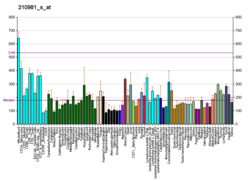GRK6
GRK6| GRK6 | |||||||||||||||||||||||||
|---|---|---|---|---|---|---|---|---|---|---|---|---|---|---|---|---|---|---|---|---|---|---|---|---|---|
 | |||||||||||||||||||||||||
| |||||||||||||||||||||||||
| 식별자 | |||||||||||||||||||||||||
| 별칭 | GRK6, GUNK6, G 단백질 결합 수용체 키나제6 | ||||||||||||||||||||||||
| 외부 ID | OMIM: 600869 MGI: 1347078 호몰로진: 37570 GeneCard: GRK6 | ||||||||||||||||||||||||
| |||||||||||||||||||||||||
| |||||||||||||||||||||||||
| |||||||||||||||||||||||||
| |||||||||||||||||||||||||
| 직교체 | |||||||||||||||||||||||||
| 종 | 인간 | 마우스 | |||||||||||||||||||||||
| 엔트레스 | |||||||||||||||||||||||||
| 앙상블 | |||||||||||||||||||||||||
| 유니프로트 | |||||||||||||||||||||||||
| RefSeq(mRNA) |
| ||||||||||||||||||||||||
| RefSeq(단백질) |
| ||||||||||||||||||||||||
| 위치(UCSC) | Cr 5: 177.4 – 177.44Mb | Cr 13: 55.59 – 55.61Mb | |||||||||||||||||||||||
| PubMed 검색 | [3] | [4] | |||||||||||||||||||||||
| 위키다타 | |||||||||||||||||||||||||
| |||||||||||||||||||||||||
이 유전자는 Ser/Tr 단백질 키나아제 계열의 G단백질 결합 수용체 키나제 하위 계열의 부재를 인코딩하며 GRK4, GRK5와 가장 유사하다.[5][6][7]단백질은 G단백질 결합 수용체의 활성 형태를 만들어 신호를 조절한다.
함수
G단백질결합수용체 키노리산 활성 G단백질결합수용체들은 수용체에 아레스틴 단백질의 결합을 촉진한다.인광 활성 수용체에 대한 아레스틴 결합은 이질성 G 단백질 변환기 단백질의 수용체 자극을 방지하여 세포신호를 차단하고 수용체 감소를 초래한다.아레스틴 결합은 또한 수용체를 특정 세포 내분화 경로로 유도하여 세포 표면에서 수용체를 제거하고 추가적인 활성화를 방지한다.인산화 활성 수용체에 대한 아레스틴 결합도 아레스틴 파트너 단백질을 통한 수용체 신호 전달을 가능하게 한다.따라서 GRK/arrestin 시스템은 G 단백질 결합 수용체에 대한 복잡한 신호 스위치 역할을 한다.[8]
GRK6 및 이와 밀접하게 연관된 GRK5 인산화 수용체들은 (반대의 효과가 있는 GRK2와 GRK3와는 대조적으로) 구속 매개 수용체 감소화, 내성화 및 인신매매보다는 구속 매개 신호를 장려하는 현장의 GRK5 인산화 수용체들이다.[9][10]이러한 차이는 수용체에 대한 약물 결합이 수용체가 그 수용체에 의해 자극된 작용의 특정 부분집합을 향해 신호를 보내는 편향될 수 있는 약리학적 편향 작용(기능적 선택성이라고도 함)의 한 가지 근거다.[11][12]
GRK6는 몸 전체에서 넓고 비교적 고르게 표현되지만 면역세포에서 특히 높은 발현을 가지고 있다.[6]GRK6는 막 연관성을 조절하는 카르복실 단자 영역에 서로 다른 세 가지 스플라이스 변형으로 존재한다. 하나는 팜티토일라이드, 다른 하나는 지질 결합 폴리 베이직 도메인을 포함하고 있으며, 세 번째는 잘려서 둘 다 없다.[13]마우스에서 GRK6는 뇌의 선조체 부위에서 D2 도파민 수용체를 조절하며, GRK6의 상실로 도파민을 통해 작용하는 심리 자극제에 대한 민감도가 높아지게 된다.[14]파킨슨병 랫드 모델에서 선조체 내 GRK6의 과다압박은 L-DOPA 치료에서 발생하는 약물유발성 운동장애(경화성 이상증) 증상을 개선한다.[15]생쥐 면역세포에서 GRK6는 화학반응성 CXCL12에 반응하는 B-림프모세포와 T-림프모세포의 화학축에 중요하며,[16] 백혈병 B4에 반응하는 부상 부위에 대한 중성미자는 중요하다.[17]
참조
- ^ a b c GRCh38: 앙상블 릴리스 89: ENSG00000198055 - 앙상블, 2017년 5월
- ^ a b c GRCm38: 앙상블 릴리스 89: ENSMUSG00007486 - 앙상블, 2017년 5월
- ^ "Human PubMed Reference:". National Center for Biotechnology Information, U.S. National Library of Medicine.
- ^ "Mouse PubMed Reference:". National Center for Biotechnology Information, U.S. National Library of Medicine.
- ^ Benovic JL, Gomez J (1993). "Molecular cloning and expression of GRK6. A new member of the G protein-coupled receptor kinase family". J Biol Chem. 268 (26): 19521–19527. doi:10.1016/S0021-9258(19)36546-9. PMID 8366096.
- ^ a b Haribabu B, Snyderman R (1993). "Identification of additional members of human G-protein-coupled receptor kinase multigene family". Proc Natl Acad Sci USA. 90 (20): 9398–9402. Bibcode:1993PNAS...90.9398H. doi:10.1073/pnas.90.20.9398. PMC 47575. PMID 8415712.
- ^ Premont RT, Inglese J, Lefkowitz RJ (1995). "Protein kinases that phosphorylate activated G protein-coupled receptors". FASEB J. 9 (2): 175–182. doi:10.1096/fasebj.9.2.7781920. PMID 7781920. S2CID 20428064.
- ^ Gurevich VV, Gurevich EV (2019). "GPCR Signaling Regulation: The Role of GRKs and Arrestins". Front Pharmacol. 10: 125. doi:10.3389/fphar.2019.00125. PMC 6389790. PMID 30837883.
- ^ Kim J, Ahn S, Ren XR, Whalen EJ, Reiter E, Wei H, Lefkowitz RJ (2005). "Functional antagonism of different G protein-coupled receptor kinases for beta-arrestin-mediated angiotensin II receptor signaling". Proc Natl Acad Sci USA. 102 (5): 1442–1447. Bibcode:2005PNAS..102.1442K. doi:10.1073/pnas.0409532102. PMC 547874. PMID 15671181.
- ^ Ren XR, Reiter E, Ahn S, Kim J, Chen W, Lefkowitz RJ (2005). "Different G protein-coupled receptor kinases govern G protein and beta-arrestin-mediated signaling of V2 vasopressin receptor". Proc Natl Acad Sci USA. 102 (5): 1448–1453. Bibcode:2005PNAS..102.1448R. doi:10.1073/pnas.0409534102. PMC 547876. PMID 15671180.
- ^ Zidar DA, Violin JD, Whalen EJ, Lefkowitz RJ (2009). "Selective engagement of G protein coupled receptor kinases (GRKs) encodes distinct functions of biased ligands". Proc Natl Acad Sci USA. 106 (24): 9649–9654. Bibcode:2009PNAS..106.9649Z. doi:10.1073/pnas.0904361106. PMC 2689814. PMID 19497875.
- ^ Choi M, Staus DP, Wingler LM, Ahn S, Pani B, Capel WD, Lefkowitz RJ (2018). "G protein-coupled receptor kinases (GRKs) orchestrate biased agonism at the β2-adrenergic receptor". Sci Signal. 11 (544): eaar7084. doi:10.1126/scisignal.aar7084. PMID 30131371.
- ^ Premont RT, Macrae AD, Aparicio SA, Kendall HE, Welch JE, Lefkowitz RJ (1999). "The GRK4 subfamily of G protein-coupled receptor kinases. Alternative splicing, gene organization, and sequence conservation". J Biol Chem. 274 (41): 29381–29389. doi:10.1074/jbc.274.41.29381. PMID 10506199.
- ^ Gainetdinov RR, Bohn LM, Sotnikova TD, Cyr M, Laakso A, Macrae AD, Torres GE, Kim KM, Lefkowitz RJ, Caron MG, Premont RT (2003). "Dopaminergic supersensitivity in G protein-coupled receptor kinase 6-deficient mice". Neuron. 38 (2): 291–303. doi:10.1016/S0896-6273(03)00192-2. PMID 12718862. S2CID 13986538.
- ^ Ahmed MR, Berthet A, Bychkov E, Porras G, Li Q, Bioulac BH, Carl YT, Bloch B, Kook S, Aubert I, Dovero S, Doudnikoff E, Gurevich VV, Gurevich EV, Bezard E (2010). "Lentiviral overexpression of GRK6 alleviates L-dopa-induced dyskinesia in experimental Parkinson's disease". Sci Transl Med. 2 (28): 28ra28. doi:10.1126/scitranslmed.3000664. PMC 2933751. PMID 20410529.
- ^ Fong AM, Premont RT, Richardson RM, Yu YR, Lefkowitz RJ, Patel DD (2002). "Defective lymphocyte chemotaxis in beta-arrestin2- and GRK6-deficient mice". Proc Natl Acad Sci USA. 99 (11): 7478–7483. Bibcode:2002PNAS...99.7478F. doi:10.1073/pnas.112198299. PMC 124256. PMID 12032308.
- ^ Kavelaars A, Vroon A, Raatgever RP, Fong AM, Premont RT, Patel DD, Lefkowitz RJ, Heijnen CJ (2003). "Increased acute inflammation, leukotriene B4-induced chemotaxis, and signaling in mice deficient for G protein-coupled receptor kinase 6". J Immunol. 171 (11): 6128–6134. doi:10.4049/jimmunol.171.11.6128. PMID 14634128.
추가 읽기
- Bullrich F, Druck T, Kunapuli P, et al. (1995). "Chromosomal mapping of the genes GPRK5 and GPRK6 encoding G protein-coupled receptor kinases GRK5 and GRK6". Cytogenet. Cell Genet. 70 (3–4): 250–4. doi:10.1159/000134045. PMID 7789183.
- Stoffel RH, Randall RR, Premont RT, et al. (1994). "Palmitoylation of G protein-coupled receptor kinase, GRK6. Lipid modification diversity in the GRK family". J. Biol. Chem. 269 (45): 27791–4. doi:10.1016/S0021-9258(18)46852-4. PMID 7961702.
- Loudon RP, Benovic JL (1994). "Expression, purification, and characterization of the G protein-coupled receptor kinase GRK6". J. Biol. Chem. 269 (36): 22691–7. doi:10.1016/S0021-9258(17)31701-5. PMID 8077221.
- Benovic JL, Gomez J (1993). "Molecular cloning and expression of GRK6. A new member of the G protein-coupled receptor kinase family". J. Biol. Chem. 268 (26): 19521–7. doi:10.1016/S0021-9258(19)36546-9. PMID 8366096.
- Freedman NJ, Ament AS, Oppermann M, et al. (1997). "Phosphorylation and desensitization of human endothelin A and B receptors. Evidence for G protein-coupled receptor kinase specificity". J. Biol. Chem. 272 (28): 17734–43. doi:10.1074/jbc.272.28.17734. PMID 9211925.
- Loudon RP, Benovic JL (1997). "Altered activity of palmitoylation-deficient and isoprenylated forms of the G protein-coupled receptor kinase GRK6". J. Biol. Chem. 272 (43): 27422–7. doi:10.1074/jbc.272.43.27422. PMID 9341194.
- Stoffel RH, Inglese J, Macrae AD, et al. (1998). "Palmitoylation increases the kinase activity of the G protein-coupled receptor kinase, GRK6". Biochemistry. 37 (46): 16053–9. doi:10.1021/bi981432d. PMID 9819198.
- Premont RT, Claing A, Vitale N, et al. (1998). "β2-Adrenergic receptor regulation by GIT1, a G protein-coupled receptor kinase-associated ADP ribosylation factor GTPase-activating protein". Proc. Natl. Acad. Sci. U.S.A. 95 (24): 14082–7. Bibcode:1998PNAS...9514082P. doi:10.1073/pnas.95.24.14082. PMC 24330. PMID 9826657.
- Milcent MD, Christophe T, Rabiet MJ, et al. (1999). "Overexpression of wild-type and catalytically inactive forms of GRK2 and GRK6 fails to alter the agonist-induced phosphorylation of the C5a receptor (CD88): evidence that GRK6 is autophosphorylated in COS-7 cells". Biochem. Biophys. Res. Commun. 259 (1): 224–9. doi:10.1006/bbrc.1999.0758. PMID 10334944.
- Lazari MF, Liu X, Nakamura K, et al. (1999). "Role of G protein-coupled receptor kinases on the agonist-induced phosphorylation and internalization of the follitropin receptor". Mol. Endocrinol. 13 (6): 866–78. doi:10.1210/me.13.6.866. PMID 10379886.
- Hall RA, Spurney RF, Premont RT, et al. (1999). "G protein-coupled receptor kinase 6A phosphorylates the Na(+)/H(+) exchanger regulatory factor via a PDZ domain-mediated interaction". J. Biol. Chem. 274 (34): 24328–34. doi:10.1074/jbc.274.34.24328. PMID 10446210.
- Brenninkmeijer CB, Price SA, López Bernal A, Phaneuf S (1999). "Expression of G-protein-coupled receptor kinases in pregnant term and non-pregnant human myometrium". J. Endocrinol. 162 (3): 401–8. doi:10.1677/joe.0.1620401. PMID 10467231.
- Pronin AN, Morris AJ, Surguchov A, Benovic JL (2000). "Synucleins are a novel class of substrates for G protein-coupled receptor kinases". J. Biol. Chem. 275 (34): 26515–22. doi:10.1074/jbc.M003542200. PMID 10852916.
- Tiruppathi C, Yan W, Sandoval R, et al. (2000). "G protein-coupled receptor kinase-5 regulates thrombin-activated signaling in endothelial cells". Proc. Natl. Acad. Sci. U.S.A. 97 (13): 7440–5. Bibcode:2000PNAS...97.7440T. doi:10.1073/pnas.97.13.7440. PMC 16564. PMID 10861009.
- Zhou H, Yan F, Tai HH (2001). "Phosphorylation and desensitization of the human thromboxane receptor-alpha by G protein-coupled receptor kinases". J. Pharmacol. Exp. Ther. 298 (3): 1243–51. PMID 11504827.
- Blaukat A, Pizard A, Breit A, et al. (2001). "Determination of bradykinin B2 receptor in vivo phosphorylation sites and their role in receptor function". J. Biol. Chem. 276 (44): 40431–40. doi:10.1074/jbc.M107024200. PMID 11517230.
- Willets JM, Challiss RA, Nahorski SR (2002). "Endogenous G protein-coupled receptor kinase 6 Regulates M3 muscarinic acetylcholine receptor phosphorylation and desensitization in human SH-SY5Y neuroblastoma cells". J. Biol. Chem. 277 (18): 15523–9. doi:10.1074/jbc.M111217200. PMID 11856737.
- Grange-Midroit M, García-Sevilla JA, Ferrer-Alcón M, et al. (2002). "G protein-coupled receptor kinases, beta-arrestin-2 and associated regulatory proteins in the human brain: postmortem changes, effect of age and subcellular distribution". Brain Res. Mol. Brain Res. 101 (1–2): 39–51. doi:10.1016/S0169-328X(02)00144-4. PMID 12007830.










